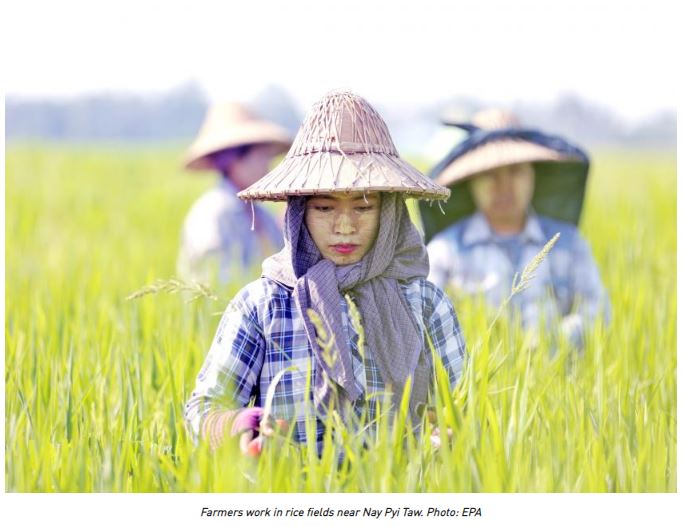Myanmar: New export strategy launched, but barriers remain
With export revenues having only increased by around US$2 billion over the past five years, Myanmar is aiming to boost its exports in the next five years by adding new sectors to its National Export Strategy (NES).
Gems and jewellery, the digital economy, fruits and vegetables, agricultural product-based food products and industrial art products have been added to the NES 2020-2025, which replaces the first NES 2014-2019, said U Aung Soe, director general at the Trade Promotion Department.
Notably, the new sectors appear to involve higher value-add and selected across a wider spectrum of industries compared to the current NES, which prioritises raw commodities including rice, pulses, oilseed crops, marine products, textile and garments and wood and wood products.
Last year, exports hit US$ 14.8 billion. For the ten months to January in the current fiscal year, exports totaled US$ 14.1 billion.
However, there are still weaknesses in quality and mass production cannot be carried out just yet. The most important thing for export promotion is to increase production. During the last five years for example, farmers were not able to achieve economies of scale for crops like rice or coffee due to the lack of technology and were unable to take advantage of export opportunities, U Aung Soe said.
“There are also a lot of issues we still face, such as the lack of infrastructure, a good economic environment, production processes and technology along the supply chain. For example, there is a need to expand the livestock breeding industry. However, breeders face technical challenges and lack of knowledge compared to neighbouring countries,” he said.
It’s a similar story in other industries. In fisheries, for example, wild supplies have lessened, so fishermen have turned to fish farming and aquaculture. Yet, they lack the knowledge to scale and expand. In Myanmar, the volume of fish produced in fish farms is three times less that of Vietnam.
“Demand for crops like avocadoes and coffee, which is available in Myanmar, is increasing across the world. But we are not able to produce sustainably here. There’s still a lot to be done to help develop the export sector,” U Aung Soe said.
He added that the first five years has not been enough for the government to deploy the reinforcements each sector needs to scale, add value and sell internationally. “Therefore, they need to continuously implement the NES over the next five years and give priority to the areas that should be expanded.”
But Myanmar economist Dr Aung Ko Ko said that although the government has launched a second five-year term for the NES, if local products are still substandard and the prices are still high with low production rates, the development of the export sector will remain slow.
“The main value of a product is in the quality and price. Prices will be high as long as the production cost is high and if there is no economies of scale. Production costs will be high because land is expensive, access to electricity is still lacking and capital is still lacking. So even though the government intends to support this sector, industries will require private sector cooperation to move forward,” he said.
Importantly, businesses and farmers themselves need to exercise discipline and cooperate with the government to grow the export sector. Dr Aung Ko Ko said that in agriculture, unfettered planting of crops which lack demand has pulverised prices and the public’s refusal to accept higher electricity charges are among the factors holding the sector back.
Meanwhile, despite the need for more funds, the government continues to cut tax to appease the public. “It is important to have effective cooperation between the government and the public. The export sector is expected to improve if all stakeholders are working together,” said U Nay Lin Zin, a local trader.
U Aung Soe added that “if exports are to be increased, export prices should be in line with the international market prices, if not less. To achieve this, there needs to be fewer brokering stages between the manufacturers or producers and the consumers. Brokers benefit neither the manufacturers nor the consumers so these stages need to be minimised.”
At this point in time though, for the country’s export sector to strengthen, there remains a need for the private sector to contribute capacity building and technical know-how for manufacturing high-value products, stronger access to financial support, more people paying taxes and better access to data.
Likewise, the government needs to provide more port facilities, upgrade roads for better transportation and also relieve trade barriers.
To be sure, big steps have been taken to encourage growth in exports since 2014, such as expanding the list of commodities which don’t need an export license, allowing the export of finished products produced from local and foreign joint ventures and relaxing import restrictions for farming machineries.
Similarly, with the launch of Myanmar National Trade Portal, information like custom tariff rates, export procedures, trade facilitation criteria set by the World Trade Organisation and market prices have been readily provided.

To improve capital access, Central Bank of Myanmar allowed trade financing by local banks in November 2017. In 2019, it extended such grants to foreign banks.
Meanwhile, the government is also taking measures to increase electricity generation to meet demand and is planning to reduce its subsidies burden by seeking advice to change tariff rates.
What’s clear is that all these measures will not happen overnight, especially with the government stretched for funds. Growth and development in the export sector is expected to be a long term endeavour.
Source: https://www.mmtimes.com/news/new-export-strategy-launched-barriers-remain.html


 English
English




